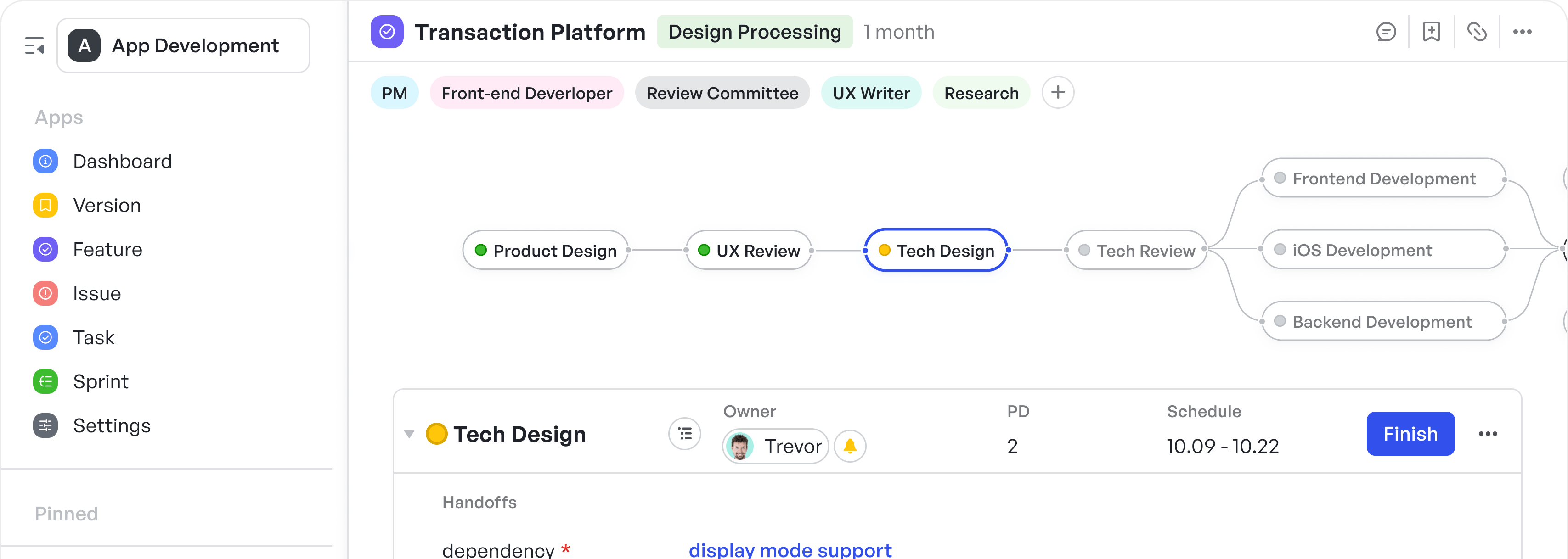Creating a product involves starting with an idea, which a committed team helps to bring to life. Take the iPhone, for instance. It began as a prototype but became a hit, thanks to the right people behind it.
Now, if you're leading a Scrum team, keeping everyone organized is essential to the product's success. So, how can development teams stay on track and reach their goals? They rely on the product backlog. It’s a structured, prioritized list of tasks, features, and essential items that align with the project’s roadmap.
If your team follows the Agile methodology, a product backlog breaks down projects into manageable pieces. This way, you can identify which tasks deserve priority.
Keep reading to discover what goes into a product backlog and how to set one up for your team.

250px|700px|reset
What Is a Product Backlog?
A product backlog is a prioritized list of tasks for the development team, based on the product roadmap and its requirements. The top items on the backlog represent the most critical tasks the team should tackle first.
Sometimes, you’ll find several product backlogs in use, especially with multiple teams working on a larger product. A great example is Adobe Creative Cloud, which serves as an umbrella product containing smaller products like Photoshop, Illustrator, and After Effects. Each of these products has its own dedicated team and product backlog for development, which helps keep everything organized and efficient.
Instead of the product owner dictating the pace, the development team pulls tasks from the backlog so they can take them on. This can happen continuously, like in Kanban, or in cycles, as seen in Scrum.
The product backlog plays a crucial role in project management, especially in the Agile methodology. It is a living document that evolves throughout the project, capturing all tasks, features, and improvements needed for the product. This dynamic nature allows teams to adapt quickly to changing priorities or market demands.
In Agile methodologies like Scrum, the product backlog is prioritized to ensure that the most valuable items are tackled first. This focus helps teams deliver high-impact features that align with stakeholder needs. During sprint planning, the team reviews the backlog, selects the highest-priority items, and commits to completing them in the upcoming iteration.
Product backlogs can take on different forms:
- Physical: This includes sticky notes, whiteboards, and index cards.
- Online: This encompasses spreadsheets, text files, mind maps, or dedicated backlog management software.
While both formats can be effective, online product backlogs are especially beneficial for remote teams. They’re user-friendly and allow for real-time updates.
Additionally, the product backlog fosters collaboration and communication among team members, keeping everyone aligned on project goals and providing transparency into what needs to be done. Regular backlog refinement sessions encourage input from all team members, ensuring that the backlog remains relevant and actionable.
Product Backlog Example
A product backlog can take various forms, often organized by components, features, or goals. Here’s an example of a product backlog that starts with a high-level objective and is then broken down into actionable tasks.
Epic or customer problem: Developing an e-commerce platform that enhances the shopping experience for users.
User story: Shoppers want an intuitive platform that simplifies the purchasing process and provides personalized recommendations.
Features for User Story:
- Create an account on the e-commerce platform
- Browse products by category
- Add items to a shopping cart
- View the cart summary and make adjustments
- Proceed to checkout with various payment options
- Receive order confirmation via email
- Track order status from the user account dashboard
This structured approach helps ensure that each task aligns with the broader vision while guiding development teams.
The Role of the Scrum Artifact: Product Backlog
The term "artifact" can refer to various things, depending on the context. In Scrum, though, it takes on a specific meaning that might surprise you. Essentially, Scrum artifacts play a crucial role in helping us track and manage progress, providing essential information that structures the entire process.
One key artifact is the Product Backlog (along with the Sprint Backlog and Product Increment), which is dynamic and updated as new information arises. It serves as the main source of tasks for the scrum team, so it must be transparent and regularly prioritized to highlight the most important items.
During sprint planning, the scrum team pulls tasks from the product backlog and moves them into the sprint backlog. To ensure effective prioritization, the product backlog should include the product goal. This goal is a target for the scrum team to plan their efforts around.
Interestingly, recent surveys show that nearly essential for staying on target with project goals.
250px|700px|reset
加载中,请稍后
Product Backlog Refinement
Product backlog refinement, sometimes called backlog grooming, is the ongoing process of evaluating and updating backlog items to make them more actionable and relevant. Regular refinement ensures that each backlog item is detailed enough for the team to start work when it’s time to pull it into a sprint.
For instance, if your sprint is two weeks long and your team works 40 hours each week, you might allocate about eight hours for backlog refinement during the sprint.
During refinement sessions, the team reviews items for clarity, relevance, and priority. A great example is Netflix’s development teams, which prioritize every backlog item based on customer needs, technical feasibility, and value to the business.
As your backlog grows, it can be helpful for product owners to categorize items. You might split them into near-term and long-term tasks. Near-term items should be well-defined before you label them as such. This means crafting complete user stories, coordinating with design and development, and getting estimates from the development team.
On the other hand, long-term items can stay somewhat vague. Still, it’s wise to gather rough estimates from the development team to aid in prioritization. This approach keeps everything organized and helps your team focus on what’s most important.
Some other best practices include:
- Prioritizing Value-Driven Tasks: Focus on items that will drive the most value and progress toward the product goal.
- Breaking Down Larger Items: Split complex tasks into smaller, more manageable pieces to improve efficiency and predictability.
- Estimating Effort: Use story points or time estimates to gauge the effort required for each task, helping the team plan realistic sprints.
Refining the backlog not only boosts productivity but also reduces ambiguity, enabling the team to jump into each sprint with a clear understanding of what needs to be accomplished.
Commitment: Product Goal
In Scrum, each artifact is linked to a specific commitment that boosts transparency and allows for progress measurement. These commitments clarify the responsibilities of the Product Owner, Scrum Master, and Developers. For the Product Backlog, this commitment is known as the Product Goal.
Essentially, the Product Goal gives context to the Product Backlog. It outlines the future state of the product, serving as a target for the Scrum Team to aim for. The Product Goal represents the long-term objective that the Scrum Team strives to achieve.
For instance, if a team’s goal is to “increase user engagement by 25% within six months,” every item in the backlog can be evaluated based on its contribution to that goal. Tech companies like Google or Adobe often create product goals that drive backlog priorities, ensuring that every Sprint contributes meaningfully toward a measurable outcome. As the team progresses through each Sprint, the Product Backlog Items detail what needs to be done to reach this goal. The Product Owner is responsible for creating and communicating this goal.
Over time, the Product Backlog changes as the Scrum Team gains insights into both their working methods and the product itself. They learn from feedback and adjust their approach based on how they are developing the product. At any given time, there is only one Product Goal for the Product Backlog, which should be clear and concise. Each Increment produced moves the product closer to the Product Goal by achieving the Sprint Goals along the way. The Product Goal is transparently shared in the Product Backlog, similar to how the Sprint Goal is displayed in the Sprint Backlog.
During the Sprint Review, the Scrum Team, along with invited stakeholders or customers, inspects the Increment and the progress made toward the Product Goal. This review process helps contextualize their findings and allows for questions about the progress. These insights can then guide Sprint Planning, helping to create focus and inform decisions for the next Sprint.
How to Effectively Manage a Product Backlog
Here's a guide to crafting and managing your product backlog with ease:
- Develop a Product Roadmap
- Develop a Product Roadmap
A product roadmap is a high-level guide that shapes the direction of your backlog. It helps outline the product's goals and influences what gets prioritized in the backlog.
The roadmap focuses on strategic goals and the "why" behind decisions, while the backlog tackles the "how." They complement each other: the roadmap sets direction, and the backlog brings the plan to life.
- Give Each Task a Clear Description
- Give Each Task a Clear Description
It's crucial that each item in your backlog is clearly defined so everyone understands it. User stories are a great way to make tasks relatable, as they’re usually written from the end user's perspective.
These stories capture requirements in agile development by focusing on what the user needs or wants to solve. For instance, a user story might say, “As a user, I want to be able to save my progress so I don’t lose my work.” They give context by stating the user’s goals, making it easier for everyone to connect with the task.
- Set Up Regular Backlog Grooming Sessions
- Set Up Regular Backlog Grooming Sessions
Holding regular backlog refinement meetings helps keep things orderly and ensures you’re always up-to-date. These sessions help your team review, re-prioritize, and break down tasks, making each one manageable.
They’re a great way to keep your backlog organized, aligned with your goals, and focused on high-value tasks. Regularly refining your backlog keeps it lean and ready for your team’s next steps.
- Make a Schedule: Choose a weekly or bi-weekly meeting time, depending on your project needs.
- Gather the Right People: Typically, the Product Owner leads with input from the development team, Scrum Master, and occasionally, stakeholders.
- Reassess Priorities: High-value tasks go to the top, while lower-value items may move down.
- Break Down Large Tasks: Split bigger tasks (epics) into smaller parts as they get closer to being tackled.
- Clear Out Irrelevant Tasks: Grooming helps you filter out anything that doesn’t add value.
- Precisely Define Backlog Priorities
- Precisely Define Backlog Priorities
Your business and customers’ needs evolve, so updating and prioritizing your backlog is important. Put the highest-priority tasks at the top and consider their impact.
Some tasks bring more customer or business value than others. Think about customer needs, business alignment, risks, and dependencies. Prioritization frameworks like MoSCoW, RICE, or the Value vs. Effort matrix help you weigh what matters most. Use data from analytics, feedback, and market insights to make these decisions thoughtfully.
- Utilize a Backlog Management Tool
- Utilize a Backlog Management Tool
Backlog management tools such as Meegle, Jira, Trello, and Asana make managing tasks easy, allowing you to assign and track progress efficiently. They help you stay organized by arranging and categorizing items, making updates straightforward.
These tools provide visibility for all, showing the status and priority of each item, which promotes transparency among team members. Collaboration is encouraged through features like tagging, comments, and real-time updates, centralizing discussions.
Additionally, many tools integrate seamlessly with other software, such as version control systems, streamlining workflows. They also support prioritization with ranking methods and planning aids for sprints or releases.
- Keep the Backlog from Getting Overloaded
- Keep the Backlog from Getting Overloaded
A backlog overflowing with ideas and tasks can become chaotic. Instead of listing every idea, focus on what's important for the next few cycles.
Here are some tips to keep things streamlined:
- Refine Regularly: Update items to match your product goals, breaking down larger tasks and removing outdated ones.
- Set Work-in-Progress (WIP) Limits: Encourage the team to complete tasks before adding new ones.
- Stick to Priorities: High-value tasks come first, helping you avoid filling the backlog with low-priority items.
- Define Acceptance Criteria: Each task should have clear criteria to avoid unnecessary additions.
Try to keep backlog items at a high level. There’s no need to create tiny, granular tasks until they’re close to being tackled. This keeps the backlog leaner and more manageable, allowing you to break items down as they move closer to development. As the backlog matures, be selective about which items stay on it and say “no” to those that don’t add real value.
- Involve Your Team in the Process
- Involve Your Team in the Process
Backlog refinement isn’t a one-person job. Involve your development team, stakeholders, and even customers when it makes sense. More input fosters a better understanding and strengthens the quality of your backlog.
Though the product owner manages the backlog, team involvement brings insights into estimating and implementing tasks effectively. A well-rounded team input leads to a backlog that’s balanced and practical.
- Update Stakeholders and Keep Communication Open
- Update Stakeholders and Keep Communication Open
Transparency with stakeholders is key to smooth backlog management. Open lines of communication and visibility into the backlog build trust and help everyone stay aligned on goals.
Make sure your backlog is accessible to all stakeholders. This helps manage expectations, clarifies the work plan, and aligns everyone. Sharing progress on development, release updates, and feedback keeps everyone in the loop. Maintaining a product changelog to announce new features is a great way to engage customers and boost retention.
- Adapt and Revise the Backlog Continuously
- Adapt and Revise the Backlog Continuously
Your backlog is a living document, evolving as your product and users’ needs shift. Adjust priorities, remove irrelevant tasks, or add new ones as circumstances change. Keeping the backlog flexible helps you stay on course.
Here’s what you can do to keep the backlog always dynamic:
- Refine Regularly: Frequent updates keep the backlog focused and relevant.
- Listen to Feedback: Use feedback from various channels to refine your backlog and improve your product.
- Reflect and Adjust: Sprint retrospectives help you fine-tune your backlog process.
- Follow Market Trends: Track the latest trends and adjust your backlog accordingly.
- Reassess Priorities Often: Things change, so periodically review your top priorities for maximum product impact.
Product Backlogs Keep Teams Agile
In Agile environments, where project requirements often evolve based on user feedback and business needs, a well-maintained backlog allows teams to adapt quickly without disrupting the overall workflow.
250px|700px|reset
加载中,请稍后
The product backlog serves as a foundation for iteration planning, encompassing all work items—user stories, bugs, design changes, technical debt, customer requests, and action items from retrospectives. This ensures that everyone's contributions are considered during each iteration's discussions, enabling team members to make informed trade-offs with the product owner before starting their work.
By clearly prioritizing tasks and aligning them with the project's strategic goals, the product backlog serves as a roadmap, ensuring that the team always knows what to focus on next. This structure empowers team members to work autonomously while staying aligned with the overall objectives, facilitating smoother sprints and a more cohesive product development cycle.
One of the key benefits of a robust product backlog is that it supports flexibility and responsiveness. Agile methodologies thrive on adapting to new information and feedback, and a dynamic backlog reflects this principle.
As the team receives customer insights or market changes, they can easily adjust the backlog to incorporate these factors, allowing for rapid pivots in direction. This adaptability not only enhances the quality of the final product but also fosters a culture of continuous improvement. Teams can regularly review and refine the backlog, ensuring it evolves with their understanding of user needs and business objectives.
Through this collaborative approach, the backlog keeps the team agile and remains nimble, responsive, and ultimately more successful in delivering high-quality products.
Meegle’s Role in Managing a Product Backlog
Meegle is a powerful tool designed to streamline the management of product backlogs in Agile development environments. By providing a comprehensive platform for tracking, prioritizing, and collaborating on tasks, Meegle enhances the efficiency and effectiveness of teams as they navigate the complexities of product development.
Collect and Prioritize Potential Features for the Backlog
In Meegle, it is easy to prioritize and manage features for the backlog, and it keeps the whole team involved. The tool provides a central place where team members can add potential features, discuss each item, and determine its importance based on project goals and customer needs.
250px|700px|reset
加载中,请稍后
During sprint planning, the team can review this list of features and rank them by priority. Meegle’s system allows teams to look at each feature’s strategic value, helping everyone see which features to work on next.
Once the team prioritizes these features, they can save them in a dedicated view, making it easy to access the list when creating the sprint backlog.
This setup helps the team focus on the most critical features, keeping the project on track without overlooking any important details.
Track New Task Progress with Kanban Backlog Views
Meegle offers various views that enhance your ability to track, organize, and prioritize tasks and for backlogs, the kanban view is particularly effective.
The Kanban View allows you to visualize your backlog on a board, providing a clear picture of task progress at a glance. This format helps teams manage workflow efficiently, moving items through various stages of completion.
250px|700px|reset
加载中,请稍后
The best part is that you can also get access to various templates that are highly customizable and flexible.
Add and Track Issues to Your Backlog
250px|700px|reset
加载中,请稍后
Start by adding new issues directly to the Kanban backlog, allowing team members to view and understand outstanding tasks at a glance. Meegle’s centralized platform helps teams prioritize these issues based on urgency or impact, ensuring that everyone has a clear view of what needs attention.
With real-time updates and customizable views, Meegle enables continuous tracking of backlog items.
Monitor Progress with Dashboard
250px|700px|reset
加载中,请稍后
Finally, you can monitor the progress of your product backlog using the Meegle Dashboard. This dashboard includes a Cumulative Flow Diagram showing task statuses, helping you visualize and control project timelines as work moves through different stages.
You can also track the Work In Progress (WIP) trend to see completion rates and the overall workload, which helps in effectively balancing tasks. Additionally, the Priority Distribution chart gives an overview of task priorities so teams can focus on high-impact items. This centralized view keeps everyone aligned with progress and priorities.
The Bottom Line
Creating a successful backlog involves much more than tracking items. It develops a clear product roadmap, encourages team involvement, promotes open communication, and stays transparent with stakeholders. The right backlog management tools can make this process easier, allowing your team to stay agile and responsive. And as you work, it’s essential to periodically assess and fine-tune your approach.
However, there is no one-size-fits-all solution. Each team, product, and organization is unique, so it's crucial to tailor your backlog practices to align with your team’s needs, your product’s goals, and your organization’s structure. The real goal is to build a culture of continuous learning and improvement.
While many tools can gather and manage customer feedback, it's vital to choose one that offers insights without complicating the process. Meegle can help you manage Agile projects in the most efficient way possible with its modern project management software. By consolidating feedback from multiple sources and effectively closing the feedback loop, Meegle supports a more engaged and efficient approach to product development.





